White Springs Farm--Home of Agnes Bevan Slosson Lewis
Introduction
Text-to-speech Audio
White Springs Farm was first established in 1801, and over its agricultural history has been used to grow grain crops, to raise sheep, to raise cattle, and as one of the largest orchards in the state. Between 1898 and at least the 1940s, White Springs was the home of Agnes Bevan Slosson Lewis, a suffragist and social activist.
Images
White Springs Manor
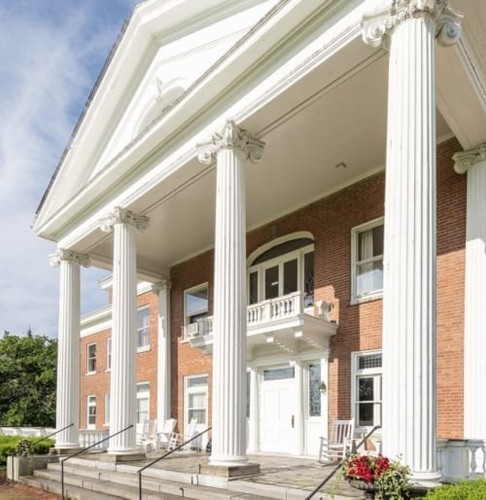
White Springs Manor
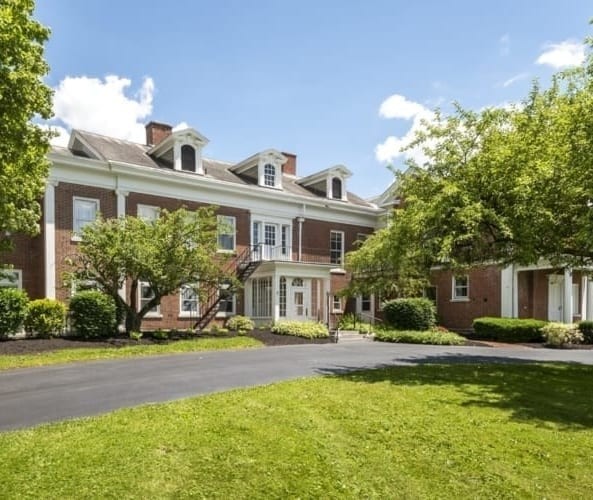
Agnes Slosson Lewis
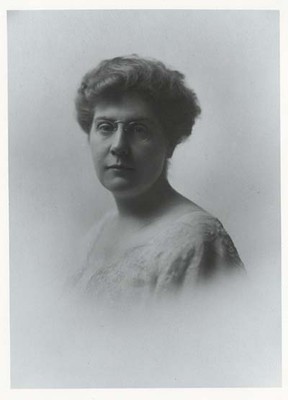
White Springs Dairy Farm, pastcard c. 1910-1920
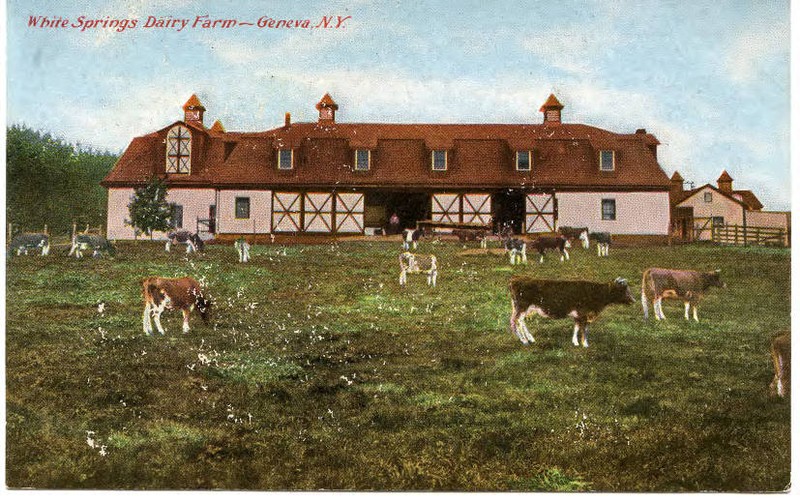
Entrance to White Springs Dairy Farm, postcard postmarked July 1911
.jpg)
"Residence on the White Springs Dairy Farm"
.jpg)
Postcard of White Springs Farm
.jpg)
Postcard of White Springs Farm, postmarked 1912
.jpg)
Summer workers hired to pick fruit at White Springs Farm cool off in the estate's pond, c. 1930
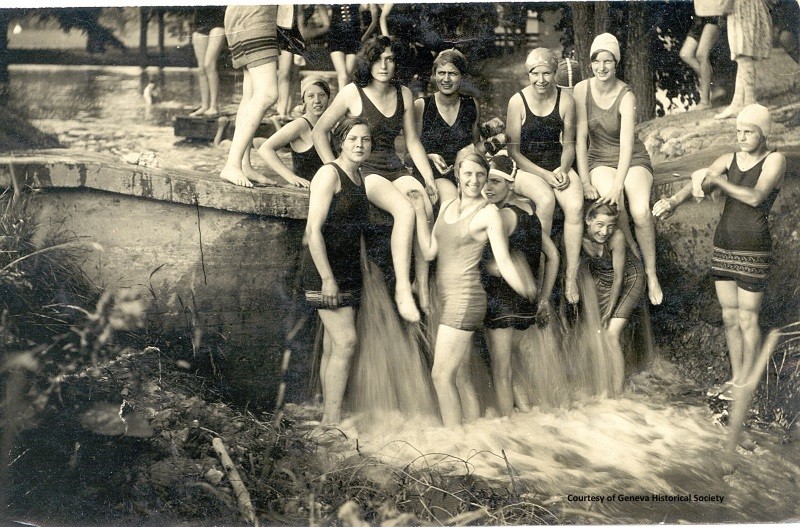
Sketch of the 1806 house from a map of Ontario County (Geneva Historical Society)
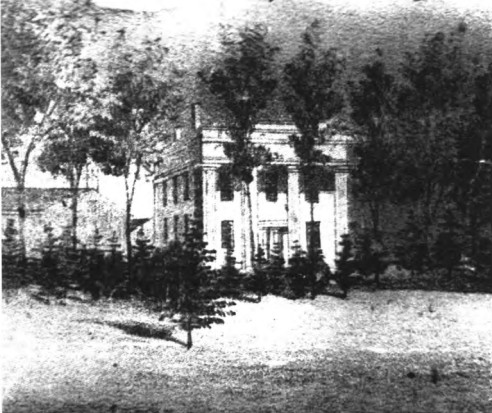
White Springs dairy barn after the 1912 cyclone.
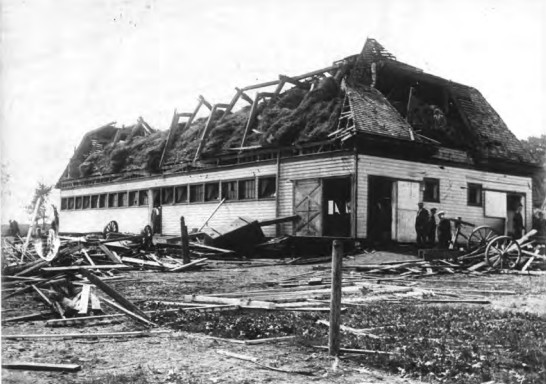
Backstory and Context
Text-to-speech Audio
Agnes Bevan Slosson was born in Geneva, NY on May 27, 1878 to Henry Lawrence and Agnes Stacy Slosson. She attended school in Geneva and Buffalo and studied voice in New York City before marrying Alfred George Lewis in September 1903. The couple settled in Geneva and had four children. Both Agnes Slosson Lewis and her husband supported women’s suffrage and were active in the Geneva Political Equality Club led by Elizabeth Smith Miller and Anne Fitzhugh Miller. Agnes Lewis served as the president of the Ontario County Woman’s Suffrage Association. After the Geneva Political Equality Club ended in 1917, Lewis helped found the Geneva Women’s Club and served as its first president. When the League of Women Voters was founded after suffrage was granted to women, Lewis was director of New York State’s Seventh Region. The League of Women Voters, Geneva awards the Agnes Slosson Lewis Award annually “to a woman exemplifying outstanding contributions to a participation in civic affairs.”
Agnes Bevan Slosson Lewis’ social activism went far beyond just working for women’s suffrage and political equality. Her other social reform activities included: member of the Board of Trustees of the Woman’s Free Rest Room, committee member of the Geneva Free Library, member of the Board of Trustees of the Geneva General Hospital, trustee for District School No. 8 in Geneva, she was on the Labor Committee of the NY Woman’s Committee for Law Enforcement, and was on the Mental Hygiene and After Care Committee for Willard State Hospital. She was a member of the Needlework Guild of America, the Consumer’s League, the Federal Council of Churches, the Ontario County Home Bureau, and the America Association for Labor Legislation.
When Alfred G. and Agnes Slosson Lewis settled at White Springs Farm, the farm had been largely abandoned for several years. Until 1779 the White Springs area was used by the Seneca people. A 1779 campaign by Maj. Gen. John Sullivan and Brig. Gen. James Clinton against Native allies of the British effectively destroyed Seneca power in the area. In 1788 the Phelps & Gorham Company struck a controversial deal to purchase the land from the Seneca, and while there was dispute over who owned the land, native claims to the area largely ceased.
The first period of the farm’s history began in the early 1800s when John Nicholas retired from his career as a lawyer and decided to go into agriculture. He purchased 900 acres at Rose Hill and 367 acres at White Springs Farm in 1801. Nicholas wanted to transfer plantation-style agriculture to this part of New York and brought 60-75 enslaved people to Geneva in addition to his extended family. John and Anne Nichols constructed the original manor house around 1806, expanded their estate to 1600 acres, and specialized in raising sheep. Their herd of 1,200 sheep was used to promote improvements in sheep-husbandry and Nicholas also built a woolen mill on his property. John Nicholas died in 1819, but Anne continued to live at the manor until her death in 1839. It is likely that the Nicholas family continued to use enslaved labor on the estate up until 1839, despite gradual emancipation progressing in New York.
Gideon Lee purchased 467 acres White Springs Farm in 1839 after serving a term in the U.S. Congress. He also had a joint stock company in tanning leather in Catskill, NY. Gideon Lee died shortly after purchasing and starting improvements on the farm, but his wife, Isabella Lee, held the property until 1857. James O. and Jane Sheldon purchased the farm from the Lee family in 1857, using it as an exhibition farm with a world-renowned herd of Short Horn Durham. In addition to his cattle, Sheldon raised wheat, oats, corn, and potatoes, particularly during the Civil War. After 1871, however, the shift of agricultural markets to the west and an economic recession, combined with the failing health of Jane Sheldon, caused James Sheldon to sell the property and move back to New York City. He sold the estate to George W. Nicholas, grandson of the original Nicholas family. After the original mansion burned in 1876, a portion of the property was sold again to William and Thomas Smith who used it as a general farm and nursery.
The Lewis family revitalized White Spring Farm. Katherine Bell Lewis purchased 260 acres of the property for her son, Alfred G. Lewis, in 1898. Alfred and Agnes Lewis increased the acreage to 900 acres, reuniting much of the original Nicholas estate, and constructed a Georgian colonial mansion on the same foundation of the original. For about fifteen years Alfred Lewis imported and raised Guernsey cattle, developing the largest herd in the world, and he opened the White Springs Dairy Company in 1905. A cyclone on September 1, 1912 heavily damaged the farm and Lewis ended up selling off the cattle herd because all the dairy barns were destroyed. Around 1920, Lewis transitioned from the cattle business to growing fruit on the property. White Springs Farm produced cherries, peaches, apples, and pears as one of the largest orchards in the state until 1946. After 1946 the family began selling off some acreage for development. The Manor was sold in 1948 to Sarah Mandigo who established the Margaret Ayre Home for adults. The home continued as a proprietary home for adults until 1997 under the Young family. After the home closed, Duane and Deb Reeder purchased White Springs Manor in 1998 as a sister property to Belhurst.
Sources
“Agnes Slosson Lewis.” Western New York Suffragists: Winning the Vote. Accessed November 26, 2021. https://rrlc.org/winningthevote/biographies/agnes-slosson-lewis/.
“Agnes Slosson Lewis Award.” League of Women Voters Geneva. Accessed November 26, 2021. https://my.lwv.org/new-york/geneva/agnes-slosson-lewis-award.
Gerard-Little, Peregrine A., Amanda K. Moutner, Kurt A. Jordan, and Michael B. Rogers. “The Production of Affluence in Central New York: The Archaeology and History of Geneva’s White Springs Manor, 1806-1951.” Historical Archaeology 50, 4 (2016): 36-64.
“History of White Springs Manor.” Belhurst Castle. Accessed November 29, 2021. https://www.belhurst.com/history/.
Valsamides, Despina. “Biography of Agnes Bevan Slosson Lewis, 1878-1960.” Biographical Database of NAWSA Suffragists, 1890-1920. Accessed November 26, 2021. https://documents.alexanderstreet.com/d/1009656373.
“History of White Springs Manor.” Belhurst Castle. Accessed December 6, 2021. https://www.belhurst.com/history/.
“History of White Springs Manor.” Belhurst Castle. Accessed December 6, 2021. https://www.belhurst.com/history/.
“Agnes Slosson Lewis.” Western New York Suffragists: Winning the Vote. Accessed December 6, 2021. https://rrlc.org/winningthevote/biographies/agnes-slosson-lewis/.
"White Springs Dairy Farm-1." New York Heritage Digital Collections. Accessed December 1, 2021. https://cdm16694.contentdm.oclc.org/digital/collection/p15109coll6/id/2168/.
"Entrance to White Springs Dairy Farm, Geneva, N.Y." New York Heritage Digital Collections. Accessed December 1, 2021. https://cdm16694.contentdm.oclc.org/digital/collection/p15109coll6/id/2169/rec/5
"Residence on the White Springs Dairy Farm, Geneva, N.Y." New York Heritage Digital Collections. Accessed December 1, 2021. https://cdm16694.contentdm.oclc.org/digital/collection/p15109coll6/id/2170/rec/6.
"White Springs Farm-3." New York Heritage Digital Collections. Accessed December 1, 2021. https://cdm16694.contentdm.oclc.org/digital/collection/p15109coll6/id/2171/rec/7.
"White Springs Farm-2." New York Heritage Digital Collections. Accessed December 1, 2021. https://cdm16694.contentdm.oclc.org/digital/collection/p15109coll6/id/2172/rec/8.
"White Springs Farm workers, circa 1930." Historic Geneva. July 17, 2015. Accessed December 6, 2021. https://historicgeneva.org/collections-and-research/digital-collection/photos/white-springs-farm-workers/.
Gerard-Little, Peregrine A., Amanda K. Moutner, Kurt A. Jordan, and Michael B. Rogers. “The Production of Affluence in Central New York: The Archaeology and History of Geneva’s White Springs Manor, 1806-1951.” Historical Archaeology 50, 4 (2016): 36-64.
Gerard-Little, Peregrine A., Amanda K. Moutner, Kurt A. Jordan, and Michael B. Rogers. “The Production of Affluence in Central New York: The Archaeology and History of Geneva’s White Springs Manor, 1806-1951.” Historical Archaeology 50, 4 (2016): 36-64.
